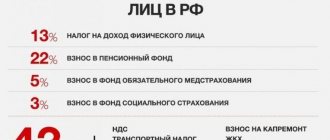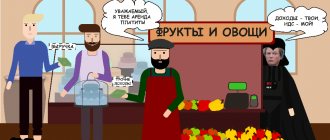What taxes do the population and business pay?
I think there is no point in discussing why we pay taxes to the state. The answer is banal and the same for all countries of the world - our money maintains old and builds new social infrastructure (schools, hospitals, kindergartens, roads, bridges, etc.), pays the labor of employees of non-profit enterprises (the so-called public sector employees), ensures the country’s defense capability, environmental protection, etc. The collection mechanism itself, the amount of tax deductions and the sharing of funds among expense items differ.
Don't be poor, learn to manage your money and increase it.
More about the course
I will briefly describe what taxes legal entities and individuals pay in Russia, and where the collected money goes. There are:
- Federal taxes and fees - VAT, excise taxes, tax on personal income, on corporate profits, on the extraction of minerals, on additional income from the extraction of hydrocarbons, water tax, fees for the use of wildlife and aquatic biological resources, state duty.
- Regional taxes – corporate property tax, gambling tax and transport tax.
- Local taxes and fees - land tax, personal property tax and trade tax.
The listed types of taxes and fees can be found in the Tax Code of the Russian Federation (Chapter 2). Tax payments go to budgets of different levels, each in its own proportion. For example, transport tax in the amount of 100% goes to the budget of the subject of the Russian Federation, and income tax on the salaries of working citizens and other types of income received - only in the amount of 85%. Where and how much should be transferred is established in the Budget Code (Articles 50, 56 and 61).
Accordingly, different levels of government draw up their budgets based on the planned revenues: they outline the items of income and expenses. There are subsidized regions that cannot fulfill their regional obligations with the taxes collected, so they receive subsidies from the center (for example, the Ivanovo region, where I live). There are donor regions that provide for themselves (for example, Moscow).
What payroll taxes are paid to the state?
Before discussing the topic of where and on what our “hard earned” earnings are spent, let’s clarify how much taxes are actually paid in 2020, and what they are.
The tax office closely monitors that companies pay taxes on time and in full. If this does not happen, then a fine is provided (for example, for understating income by 20% of the unpaid amount in accordance with Article 123 of the Tax Code of the Russian Federation).
Income tax
- Personal income tax is deducted by the employer from the employee’s salary on a monthly basis. For this reason, everyone receives an amount less than what was agreed upon when signing the employment contract.
- In 2022, the tax calculation remained the same as last year, 2018.
- It is calculated simply. If an employee has the right to a deduction, for example, for children, then it is deducted from the salary and then multiplied by the tax figure.
- in 2022, 13% - income tax (personal income tax) is assigned for residents, highly qualified specialists who work in the Russian Federation under a patent and for foreigners from the EAEU.
- 30% - income tax for non-residents.
What other contributions are paid?
Absolutely all companies and employers are required to pay insurance premiums to the Federal Tax Service, the tariff of which is established by Art. 426 - 429 NK. They are also calculated from payments accrued to employees, as well as to those who work under civil contracts.
- The total contribution is 30%.
- Some companies pay reduced insurance premiums if required by law.
- There are no changes in 2022, and many companies and entrepreneurs are deprived of benefits.
- The Social Insurance Fund also includes insurance premiums for industrial accidents and occupational diseases. There are no changes this year.
- Contributions are paid no later than the 15th of each month.
It was decided not to introduce a luxury tax in 2022 (only amendments - if there is a car with a power above 410 horsepower, then additional funds will be charged).
Additional (indirect) taxes
- VAT - value added tax is paid by all companies that produce any goods or provide any services. The final price for an ordinary buyer already includes this fee, amounting to 7% for food products, 9% for non-food products, 50% for vodka and more than 25% for gasoline.
- Land, transport and property taxes are paid to the Federal Tax Service once a year.
- Since 2022, 3 more have been introduced - environmental, tourist and tax on self-employed citizens.
According to PricewaterhouseCoopers, a Russian on average paid 47.4% (data for 2016) to the state, and Moscow State University reported a more accurate amount - 48%. That is, half of the income is given to the state. Where is it spent?
Main areas of spending tax revenues
The main expenditure items of budgets according to the Budget Code (Article 69):
- Social security of the population. Our state positions itself as social. Let's check if this is true when we look at expense items in 2022 and 2022.
- Servicing public debt, which has been growing in absolute and relative terms (as a percentage of GDP) in recent years.
- Interbudgetary transfers. These are subsidies, subsidies and other transfers from the federal budget to the budgets of the constituent entities of the Russian Federation.
- Budget investments in projects initiated not by state, but by commercial enterprises.
- Purchase of goods, works and services for state and municipal needs.
- Subsidies for legal entities (except for government agencies) and individuals, including individual entrepreneurs.
- Transfers for legal claims, if any, against the Russian Federation, constituent entities of the Russian Federation and municipalities in order to compensate for damage caused by representatives of these branches of government to an individual or legal entity.
Anyone can study the open part of the federal budget for the current and 2 subsequent years. Published on the official website of the Ministry of Finance, this document is called “Budget for Citizens”. It is there that you can see in numbers the items of the income and expenditure parts. And next year compare them with the actual data in the budget execution document.
More than 100 cool lessons, tests and exercises for brain development
Start developing
In addition, regional authorities publish information on income and expenses in the public domain. For example, in Moscow it can be found on the “Open Budget of the City of Moscow” website, and in the Ivanovo region on the website of the regional administration.
Regional authorities can spend collected taxes on:
- creation of communal infrastructure for the population (electricity, water, gas supply, sewerage);
- providing fuel to citizens;
- improving the living conditions of low-income citizens;
- construction and maintenance of housing stock;
- providing leisure for residents, etc.
Tax deduction
Self-employed people are entitled to a tax deduction. That is, the tax can be reduced by up to 100,000 rubles.
The amount of tax deduction is determined as follows:
- Rate 4% - 1% of the tax base;
- Tariff 6% - 2% of the tax base.
If the taxpayer has no debts, the tax that must be paid from 07/1/2020 to 12/31/2020 can be reduced by the amount of the tax deduction, increasing it by 12,130 rubles. If there is still a debt, the unused tax deduction is applied to pay it off. The remainder of the deduction (if any) is used to reduce the tax.
The period for using the tax deduction has no restrictions, but after application it is not granted again. Taxpayers who de-registered and then regained their rights as self-employed have the right to count on the renewal of unused tax deductions.
The tax reduction by the amount of the deduction is made by the Federal Tax Service independently.
Budget expenditures in 2022 and analysis of their implementation
Let's see where we planned to send our money within the federal budget in 2022 and how much we fulfilled the plan at the end of the year.
What and how much should they have spent?
Based on infographics from the presentation of the Ministry of Finance, I compiled a table of income and expenses that the Government planned for 2022.
| Income | Expenses | ||
| Article | Amount, billion rubles | Article | Amount, billion rubles |
| Mineral extraction tax (MET) | 5 979,3 | Social politics | 5 004,1 |
| Export customs duties | 1 726,1 | National Defense | 3 087 |
| Excise tax on crude oil sent for processing | – 329,1 | National economy | 2 658,4 |
| Tax on additional income from the production of hydrocarbons (ATI) | 95,9 | National Security and Law Enforcement | 2 430,4 |
| VAT | 7 492,4 | National issues | 1 557,4 |
| Corporate income tax | 1 210,3 | Healthcare | 1 027,9 |
| Excise taxes | 1 085,7 | General interbudgetary transfers | 1 010,2 |
| Import duties | 656,3 | Education | 912,5 |
| Others | 2 462,4 | Servicing state and municipal debt | 897 |
| Environmental protection | 343,8 | ||
| Department of Housing and Utilities | 260,8 | ||
| Culture, cinematography | 144,4 | ||
| Mass media | 94,8 | ||
| physical Culture and sport | 74,7 | ||
At first glance, it is clear that the most money is spent on social policy - 5,004.1 billion rubles. But total expenditures on defense and security amount to 5,517.4 billion rubles. Despite the fact that the growth in healthcare costs was set at 50%, this item took a modest 6th place with costs 5 times less than for the defense industry.
An amazing thing with housing and communal services. Expenses for it were reduced by 17.7%. Apparently, we have completely eliminated the deterioration of communications and other housing and communal infrastructure. Only the pipes in front of my house regularly indicate otherwise.
How the plan was implemented
We reviewed the spending plan for 2022. There is also a report on its implementation at the link. Initially they planned to spend 19,503.3 billion rubles. But at the end of 2022, costs increased by 4,339.2 billion rubles. True, we managed to master 4.3% less.
The largest share in the volume of expenses was made up of interbudgetary transfers (39%), purchases of goods, works and services to meet state (municipal) needs (18%) and expenses for payments to personnel of state (municipal) authorities and government institutions (14%).
Money was allocated for the implementation of 43 government programs, which were combined into 5 areas:
- New quality of life.
- Innovative development and modernization of the economy.
- Ensuring national security.
- Balanced regional development.
- An effective state.
Budget revenues and expenses in 2022
2021 is in full swing. Let's see what the money will be used for this year, including those collected in the form of taxes from citizens and businesses. Let's use infographics from the Ministry of Finance.
How much do we plan to receive?
Please note that we divide all income into 2 categories:
- oil and gas,
- non-oil and gas.
The state is striving to reduce the share of the former, but so far an increase has been planned for the next 3 years. Last year, the Ministry of Finance made a schedule for reducing the dependence of our budget on oil and gas revenues from 2022. This year there is no such schedule.
| Income | 2020 | 2021 | 2022 | 2023 |
| Oil and gas | 28,7 % | 31,9 % | 33,4 % | 33,6 % |
| Non-oil and gas | 71,3 % | 68,1 % | 66,6 % | 66,4 % |
In 2022 they planned to receive:
- VAT – 7,582.8 billion rubles (+10.8% compared to 2022)
- Mineral extraction tax – 4,212.8 billion rubles (+10.2%).
- Export customs duties – 1,246.1 billion rubles (+15.8%).
- Corporate income tax – 1,197.8 billion rubles (+21.3%).
- Excise taxes – 1,057.2 billion rubles (+5.8%).
- Import customs duties – 701.1 billion rubles (+19.9%).
- AIT – 636.7 billion rubles (+339.7%).
- Personal income tax – 60 billion rubles.
- Others – 2,179 billion rubles (-32.4%).
A new item of income has appeared - personal income tax in terms of tax on income from deposits and additional income by increasing the rate from 13 to 15% on income over 5 million rubles.
Where will we spend the money?
We plan to spend:
- Social policy – RUB 5,692.9 billion (-17.7% compared to 2020)
- National economy – 3,328.3 billion rubles (-6.1%%).
- National defense – 3,113.2 billion rubles (-5.9%).
- National security and law enforcement – 2,456.7 billion rubles (+4.4%).
- National issues – 1,582.6 billion rubles (-18.5%).
- Servicing state and municipal debt – 1,230.9 billion rubles (+42%).
- Healthcare – 1,129.4 billion rubles (-16.6%).
- Education – 1,082.7 billion rubles (+7.8%).
- Interbudgetary transfers of a general nature – 969.2 billion rubles (-30.3%).
- Environmental protection – 335.7 billion rubles (+11.5%).
- Housing and communal services – 322.2 billion rubles (-26.2%).
- Culture, cinematography – 135.1 billion rubles (-7.5%).
- Media – 102.8 billion rubles (-8%).
- Physical culture and sports – 65.3 billion rubles (-20%).
Compared to 2022, we have reduced spending on social policy, healthcare, housing and communal services, the national economy, defense and some other items that were already at the bottom of the list. Expenditures on debt servicing and environmental protection increased significantly, while expenses on education increased slightly.
The year is not yet over, so there are no actual results of budget execution yet. But the picture is not encouraging. I see almost no increase in spending anywhere except for national security, the environment, and education. It is sad.
What is personal income tax
The abbreviation NDFL stands for “personal income tax.” In most cases, this tax is calculated as 13% of income. The main exception is winnings, which are subject to a 35 percent tax (that is, of the 10,000 rubles won in the lottery, the state will have to pay 3,500).
Taxes for an officially working citizen are paid by his employer (tax agent). It turns out that the salary arrives on the card every month minus tax.
If a citizen had other income (or the employer did not pay taxes for some reason), he is obliged to submit an income declaration to the tax office at the place of registration (“registration”). To do this, you need to download the so-called 3-NDFL form from the tax office website, carefully fill it out and send it or take it to the inspectorate. This must be done no later than April 30, thereby reporting for the previous year.








